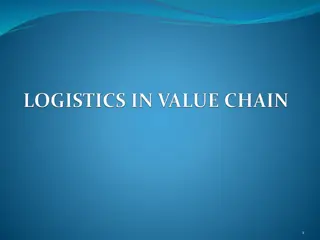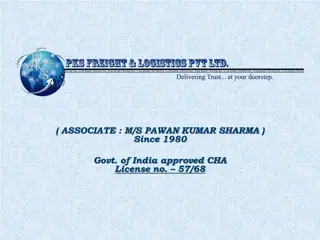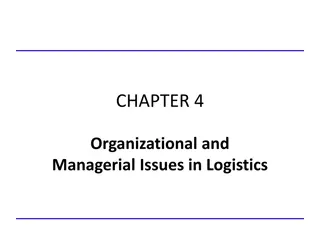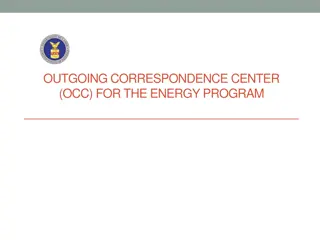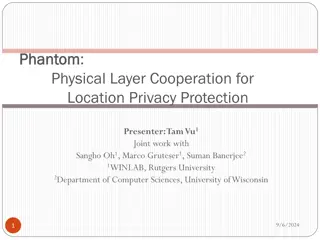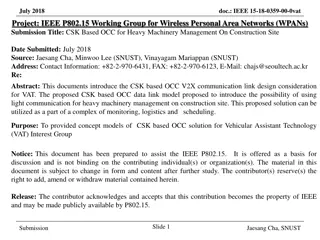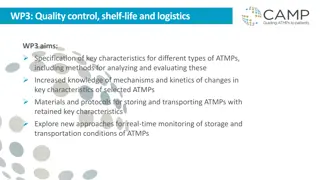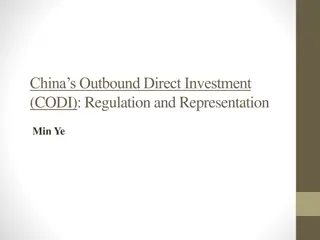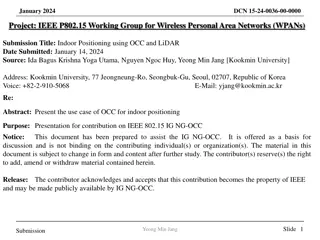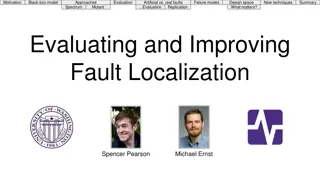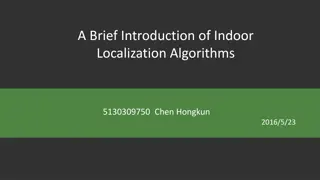Location Localization OCC Link for Outbound Logistics
This submission introduces the OCC V2X communication link design for VAT, focusing on utilizing light communication for outbound logistics management. It includes concepts for monitoring, logistics, and scheduling within logistics centers.
Download Presentation

Please find below an Image/Link to download the presentation.
The content on the website is provided AS IS for your information and personal use only. It may not be sold, licensed, or shared on other websites without obtaining consent from the author.If you encounter any issues during the download, it is possible that the publisher has removed the file from their server.
You are allowed to download the files provided on this website for personal or commercial use, subject to the condition that they are used lawfully. All files are the property of their respective owners.
The content on the website is provided AS IS for your information and personal use only. It may not be sold, licensed, or shared on other websites without obtaining consent from the author.
E N D
Presentation Transcript
Ordinary Differential Equations Second Order Linear ODE Abadi Universitas Negeri Surabaya
Mechanical & Electrical Vibrations Two important areas of application for second order linear equations with constant coefficients are in modeling mechanical and electrical oscillations. We will study the motion of a mass on a spring in detail. An understanding of the behavior of this simple system is the first step in investigation of more complex vibrating systems.
Spring Mass System Suppose a mass m hangs from vertical spring of original length l. The mass causes an elongation L of the spring. The force FG of gravity pulls mass down. This force has magnitude mg, where g is acceleration due to gravity. The force FS of spring stiffness pulls mass up. For small elongations L, this force is proportional to L. That is, Fs= kL (Hooke s Law). Since mass is in equilibrium, the forces balance each other: mg= kL
Spring Model We will study motion of mass when it is acted on by an external force (forcing function) or is initially displaced. Let u(t) denote the displacement of the mass from its equilibrium position at time t, measured downward. Let f be the net force acting on mass. Newton s 2ndLaw: = ( ) ( ) m u t f t In determining f, there are four separate forces to consider: Weight: w = mg Spring force: Fs= - k(L+ u) (up or down force, see next slide) Damping force: Fd(t) = - u (t) (up or down, see following slide) External force: F(t) (downward force) (up or down force, see text)
Spring Model: Spring Force Details The spring force Fs acts to restore spring to natural position, and is proportional to L + u. If L + u > 0, then spring is extended and the spring force acts upward. In this case ??= ?(? + ?) If L + u < 0, then spring is compressed a distance of |L + u|, and the spring force acts downward. In this case ??= ? ? + ? = ? ? + ? In either case, ??= ?(? + ?) = ?(? + ?)
Spring Model: Damping Force Details The damping or resistive force Fdacts in opposite direction as motion of mass. Can be complicated to model. Fdmay be due to air resistance, internal energy dissipation due to action of spring, friction between mass and guides, or a mechanical device (dashpot) imparting resistive force to mass. We keep it simple and assume Fdis proportional to velocity. In particular, we find that If u > 0, then u is increasing, so mass is moving downward. Thus Fdacts upward and hence Fd= - u , where > 0. If u < 0, then u is decreasing, so mass is moving upward. Thus Fdacts downward and hence Fd= - u , > 0. In either case, ??? = ?? ? , ? > 0.
Spring Model: Differential Equation Taking into account these forces, Newton s Law becomes: ) ( ) ( u L k mg + = = + + + ( ) ( t ) m u t mg F t F t F t s d + ( ) ( ) ( ) t u F t Recalling that mg = kL, this equation reduces to ) ( ) ( t u t u m + + Second order ordinary differential equation = ( ) ( ) ku t F t where the constants m, , and k are positive. We can prescribe initial conditions also: , ) 0 ( u u u = ) 0 ( = v 0 0 It follows from Theorem 3.2.1 that there is a unique solution to this initial value problem. Physically, if mass is set in motion with a given initial displacement and velocity, then its position is uniquely determined at all future times.
Second Order Linear Homogeneous ODE with Constant Coefficients A second order ordinary differential equation has the general form , , ( y t f y = ) y where f is some given function. This equation is said to be linear if f is linear in y and y': t p t g y ( ) ( = ) ( ) y q t y Otherwise the equation is said to be nonlinear. A second order linear equation often appears as ) ( ) ( y t Q y t P + + = ( ) ( ) R t y G t If G(t) = 0 for all t, then the equation is called homogeneous. Otherwise the equation is nonhomogeneous.
Homogeneous Equations, Initial Values The focus of this chapter is thus on homogeneous equations; and in particular, those with constant coefficients: + + cy y b y a = 0 Initial conditions typically take the form ( ) 0 t y = ( ) 0 t 0 = , y y y 0 Thus solution passes through (t0, y0), and slope of solution at (t0, y0) is equal to y0'.
Example 1: Infinitely Many Solutions (1 of 3) Consider the second order linear differential equation 0 = y y Two solutions of this equation are t e t y = , ) ( 1 = t ( ) y t e 2 Other solutions include t y = ) ( 3 = = + t t t t 3 , ( ) 5 , ( ) 3 5 e y t e y t e e 4 5 Based on these observations, we see that there are infinitely many solutions of the form t t e c e c t y + = 2 1 ) ( It will be shown in Section 3.2 that all solutions of the differential equation above can be expressed in this form.
Example 1: Initial Conditions (2 of 3) Now consider the following initial value problem for our equation: , 3 ) 0 ( , 0 = = y y y y ) 0 ( = 1 We have found a general solution of the form t t e c e c t y + = 2 1 ) ( Using the initial equations, ) 0 ( 1 = c y = + = 3 y c c 2 = = , 2 1 c c 1 2 = ) 0 ( 1 c 1 2 = 2 + t t ( ) y t e e Thus
Example 1: Solution Graphs (3 of 3) Our initial value problem and solution are y y y y = = , 3 ) 0 ( , 0 ) 0 ( = = + t t 1 ( ) 2 y t e e Graphs of this solution are given below. The graph on the right suggests that both initial conditions are satisfied.
Characteristic Equation To solve the 2nd order equation with constant coefficients, = + + cy y b y a , 0 Substituting this into the differential equation, we obtain we begin by assuming a solution of the form y = ert. + + = 2 rt rt rt 0 ar e bre ce Simplifying, + + + = = 2 ert ( ) 0 0 ar ar br + c c and hence 2 br This last equation is called the characteristic equation of the differential equation. We then solve for r by factoring or using quadratic formula.
General Solution Using the quadratic formula on the characteristic equation , 0 = + + c br ar 2 we obtain two solutions, r1 and r2. There are three possible results: The roots r1, r2 are real and r1 r2. The roots r1, r2 are real and r1 = r2. The roots r1, r2 are complex. In this section, we will assume r1, r2 are real and r1 r2. In this case, the general solution has the form t r e c t y 1 ) ( + = 2 4 b b 2 ac = r a r t c e 1 2 2
Distinct Roots of Characteristic Equation 0 + + = = = , 0 ( ) , ( ) , a y b y cy y t y y t y 0 0 0 For the initial value problem = + r t r t ( ) y t c e c e 1 2 1 2 we use the general solution + = r t r t 0 c e c e y y y r y r y 1 0 2 0 together with the initial conditions to find c1 and c2. That is, 0 2 2 1 1 y e r c e r c = + 1 2 0 = = r t r t , 0 r 0 2 0 r 1 c e c e 1 0 2 0 1 2 r r r t r t 1 0 2 0 1 2 1 2 Since we are assuming r1 r2, it follows that a solution of the form y = ertto the above initial value problem will
Example 2 Consider the initial value problem , 0 12 = + y y y ) 0 ( y = = ) 0 ( y , 0 1 Assuming exponential soln leads to characteristic equation: 12 ) ( + = r r e t y ( )( ) 0 3 = = + 2 rt 0 4 r r Factoring yields two solutions, r1 = -4 and r2 = 3 The general solution has the form t e c e c t y 2 1 ) ( + = 4 3 t Using the initial conditions: + = 0 c c 1 1 1 + 2 = = , c c 1 2 = 4 3 1 c c 7 7 1 2 Thus 1 1 = + 4 3 t t ( ) y t e e 7 7
EXERCISE Consider the initial value problem below, find the solution of IVP ( ) 0 ( ) 3 0 y + = = = 2 3 , 0 , 1 y y y 1. ( ) 0 ( ) 3 0 y + + = = = 5 6 , 0 , 2 y y y y 2.



